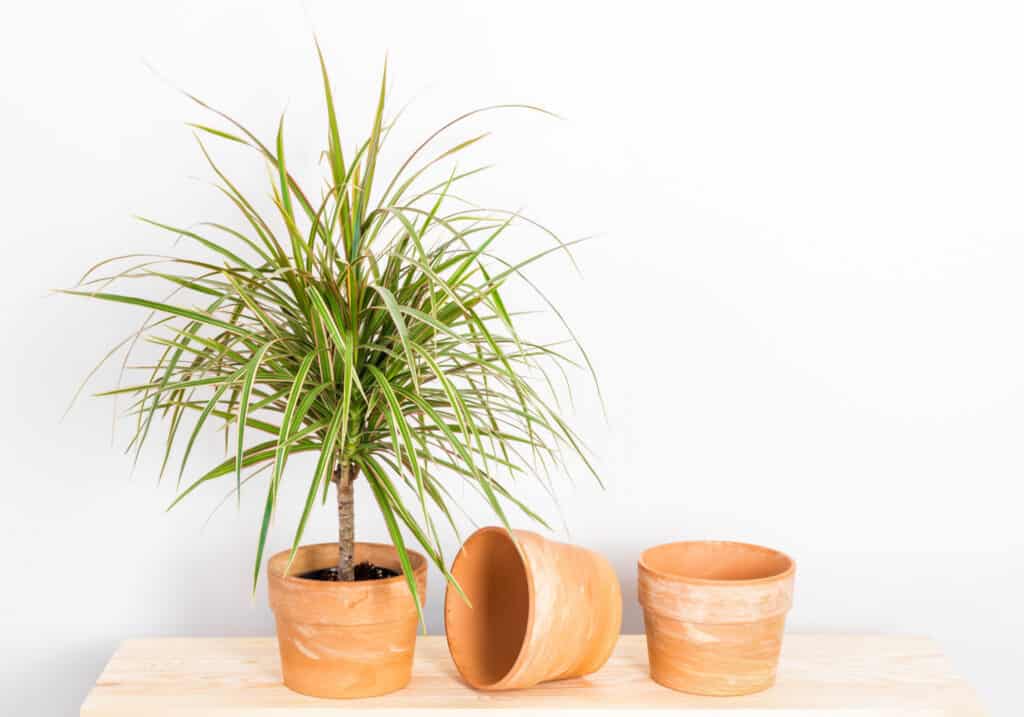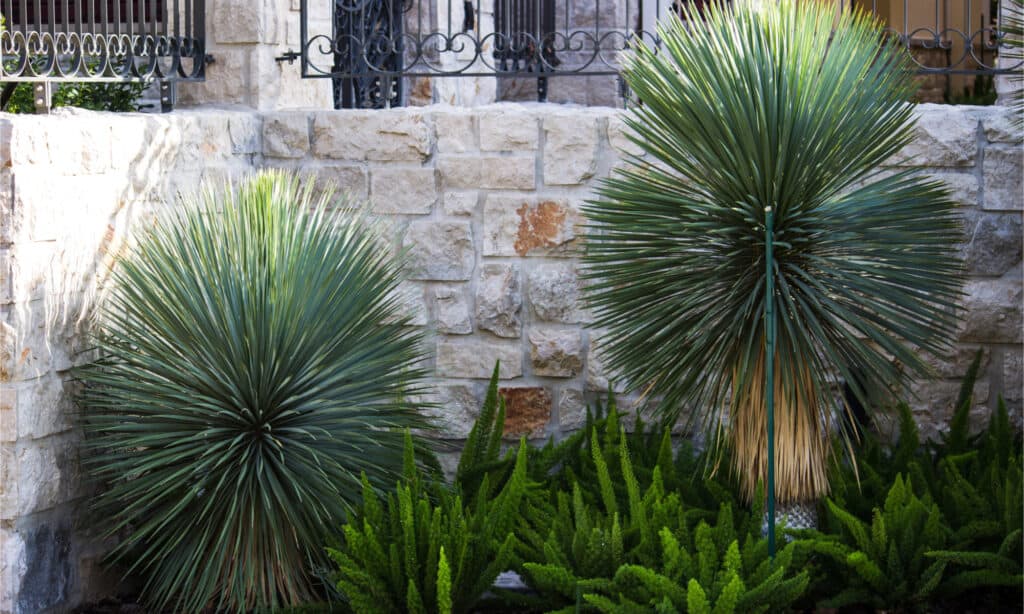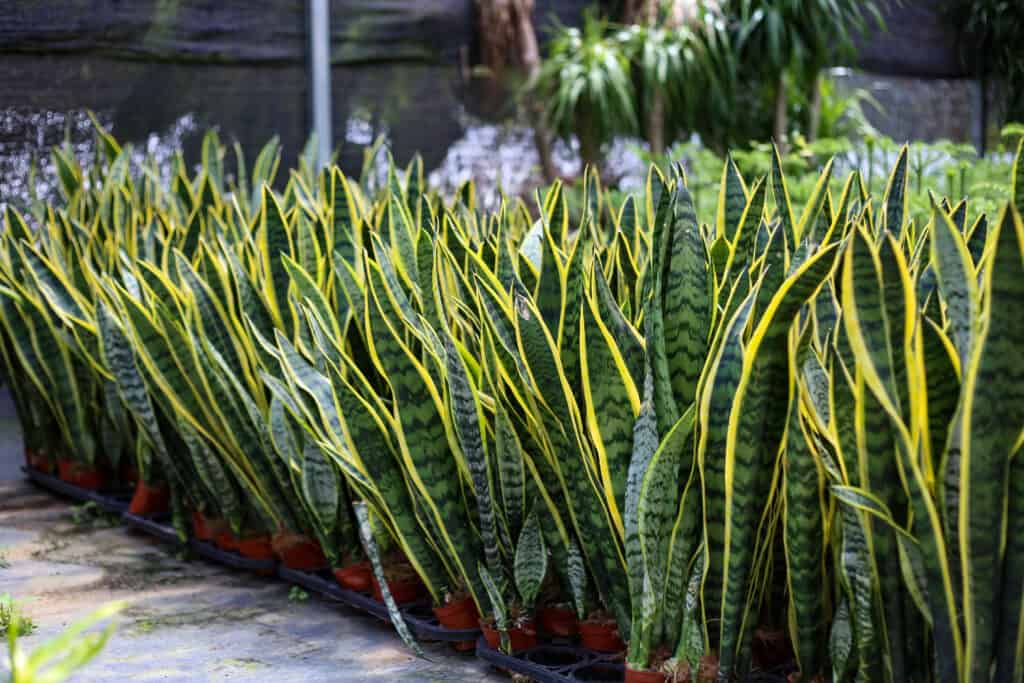Dracaena and Yucca plants are both warm-weather plants with long, stringy green leaves, so they’re easily confused. Plus, there are tons of varieties of each, which adds to the confusion about what a Dracaena or a Yucca looks like.
It’s important, however, to know which plant you’re dealing with because they’re native to completely separate climates and therefore grow very differently. Despite a handful of similarities, these plants have very distinct care needs and conditions in that they will grow in.
In this article, I’ll explain what distinguishes Dracaena from Yucca plants and the specific needs of each so you can have a healthy and thriving plant!
Dracaena vs. Yucca at a Glance
About Dracaena Plants
Dracaena is actually a genus of plants that includes over 150 varieties, each of which is a specific species. The Dracaena genus is part of the larger Asparagaceae family, which is the family that asparagus comes from!
Dracaena plants are native to the tropical regions of central Africa and southern Asia. Their tropical origins distinguish them from desert-dwelling Yucca plants and have a big influence over how they need to be cared for.
Each species of Dracaena has its unique look, growth habits, and care needs. The information in this article is generally applied to all Dracaena species, but for particular information, you’ll need to know the species of the plant.
Several species of Dracaena are popular houseplants, like the bicolor dragon tree (Dracaena marginata “bicolor”) or corn plant (Dracaena fragrans).

Studio Light and Shade/Shutterstock.com
About Yucca Plants
Yucca is also a genus of plants, although much smaller — only including about 40 species. Joshua Trees are a part of this genus!
While many species of Yucca and Dracaena look similar, their origins are completely different. Yucca plants are part of the Agavaceae family of plants that are native to the dry and arid parts of Central America, Mexico, and the southwestern United States. Agave plants are also in this family.
To eliminate some confusion, Yucca plants are different from yuca root. Yuca, also commonly called Cassava, is a root vegetable that grows in Central and South America but is not at all related to the Yucca genus.
Looks
Appearance is the main reason why Dracaena and Yucca plants are confused. First off, since there are so many different species of each genus, you have a range of plants that vary in looks but are all called Dracaena or Yucca. Also, many of these species look similar to the other genus.
Both Dracaena and Yucca plants are considered small trees or large shrubs, but generally, Dracaena plants grow in more of a tree form than Yucca plants do. Dracaena plants may grow with several trunks, but still have an upward growth habit and, even as young plants, resemble small trees.
Though they can get quite large, Yucca plants often grow in a rounded shrub-like way. Even at full maturity, most Yucca plants don’t develop much of a trunk. Although, some species look very similar to palm trees.

Zarko Prusac/Shutterstock.com
Leaves
Most of these species have thin, slender, and straight leaves that are pointed and grow out from the center. Many species of both genera have green leaves, although there’s a large range of leaves with light green, yellow, or even pink coloring.
Dracaena species tend to have darker green leaves and more variation in color than Yucca plants. A strong indicator of Dracaena vs. a Yucca plant is that the leaves of Dracaena plants drop when they die and leave a little scar on the stem.
In contrast, when the leaves of a Yucca plant die they remain attached and pile up at the base of the plant. Yucca plant leaves are typically more upright and strict than those of Dracaena plants.
Yucca leaves can be one to three feet long, generally longer than Dracaena plants’ leaves. Yucca leaves are also pointed at the end and sharp, with some varieties having dangerously sharp tips!
Flowers
Both Dracaena and Yucca plants flower in either summer or early fall, but the blooming season really depends on the specific species.
Dracaena plants have small flowers that bloom in circular clusters all over the plants. These clusters are fairly small, only several inches across, and pop up along all the stems. The flowers can be white or light pink or purple.
Yucca plants have only one, quite large flower that blooms from the center of the plant. The flowers are typically one to two feet tall, however, the larger varieties can produce flowers up to 13 feet tall!
Yucca plant flowers can be soft white, pink, light purple, or pale green. All Yucca plants are perennials, which means that they bloom with new flowers every year.
Although, some species of Yucca are monocarpic, which means that they’ll bloom with one flower one time and once it has bloomed, the plant begins to decline and is at the end of its life.

iStock.com/Joimi Joh Abi
Size
Dracaena plants tend to be smaller than Yucca pants, but, again, this depends on the species you’re looking at. Dracaena plants are more popular as houseplants, so there are many cultivars that are bred to stay smaller and manageable for growing indoors. At most, when growing naturally outdoors, Dracaena plants can grow to 6 to 10 feet tall.
Yucca plants are more commonly grown outdoors where they have the space to grow much bigger. On average, mature Yucca plants can reach three to eight feet tall. Although, when growing in the wild, some Yucca plants will grow to 30 feet tall!
Placement
It’s a lot more common that Dracaena plants are grown as houseplants than Yucca plants. We tend to see Yucca plants grown outdoors in homes in the south as part of landscaping or in gardens.
This is mostly because Dracaena plants prefer warmer temperatures and the room temperature of our homes is often perfect. Dracaena plants are not at all cold hardy and any temperatures below 50 or 60 F really stunts their growth or even kills them.
Yucca plants, however, have a fairly strong tolerance to cold since they’re desert plants. In fact, some varieties can withstand temperatures down to 10 F. Most Yucca plants grow in the southern U.S., in Zones 9 through 11, but some are cold hardy even up to Zone 5. Of course, Yucca plants can be grown indoors too, it’s just not as common.

iStock.com/Todd Hogrefe
Growth Rate
Dracaena and Yucca plants are both very slow growers and can take decades to reach their mature height. Both plants also grow faster outdoors, given the growing conditions are right, and will be smaller indoors.
Dracaena plants grow about 1.5 feet per year when growing indoors. Most species take about ten years to reach full height. Dracaena plants are very sensitive to sudden temperature change, especially to sudden drops in temperature, and such changes can really prevent them from growing.
Yucca plants also take their time- growing 1.5 feet per year indoors and 2 feet per year outdoors. Although, Yucca plants have a much better tolerance for temperature changes, and generally for colder weather.
Yucca plants are very resilient once they get growing and can handle almost any kind of situation — intense heat, cold winters, droughts, or storms. In fact, many people actually have problems trying to get rid of Yucca plants because they’re such tough and persistent growers.
Sunlight Needs
This is one area where Dracaena and Yucca are actually very similar, since they each play similar roles in their native ecosystems, despite these ecosystems being so different. Dracaena and Yucca plants both thrive with bright, indirect light.
For both, it’s best to place these plants in a spot where they’ll receive several hours of indirect sunlight every day, like a west-facing window or spot in the garden. Both Dracaena and Yucca plants will have slower growth if they don’t get enough sunlight.
There are some species of Dracaena that can handle full sun every day, but this is more an exception than the norm and you should double-check which species you have for this.
Most Yucca plants are quite sensitive to direct light and will get sunburnt if they’re left in direct light for too long. This causes damage on the leaves and in some cases intense dehydration.
Water Needs
Dracaena are tropical plants, so they thrive with moisture and prefer soil that is constantly moist and never completely dried out. The soil shouldn’t be dry, but also you don’t want to overwater these plants and risk root rot from wet soil.
Dracaena need consistent watering, about once a week in the spring and summer months. In the fall, you can water about twice a month, then in the winter stop completely during its dormant season.
Yucca plants, however, are very drought tolerant and actually aren’t capable of soaking up lots of water if they’re overwatered. If watered too often, Yucca plants will be sitting in wet water, the perfect conditions for fungi to develop.
It’s best to water Yucca plants once or twice a month with a deep watering. In the fall and winter, you can water even less.
Soil Type
Dracaena plants do best growing in rich and well-draining soil that has lots of moisture and nutrients. Since these plants are tropical, they’re built to grow in a wet environment with lots of nutrients.
Yucca plants are almost the opposite: being from the desert, they grow well in sandy and dry soil that easily looses water. These plants are not used to growing in soil that holds water, so their root system doesn’t have the means to absorb lots of water.
Both plants prefer a soil that’s slightly acidic, ranging from 6.0 to 6.5 pH.
Fertilizer
One more big difference between the needs of Dracaena and Yucca plants is their fertilizer uptake. Neither of these plants needs fertilizer to be healthy, but Dracaena will benefit from it much more than Yucca plants will.
Dracaena plants consume quite a lot of nitrogen, so they could use an extra dose from liquid fertilizer.
In the summer, when the plant is growing the most, it’s helpful to water once a week or every other week.
However, Yucca plants don’t need to be fertilized at all. These plants are already very resilient, plus they don’t consume very much nutrients to begin with. Yucca plants are super low maintenance and pest resistant, so they don’t need much of a boost.
Tropical Dracaena vs. Desert Yucca
By now you can see that there are lots of differences between these two plants, and I hope that it’s very clear how to tell which is which. It helps a lot if you know the species of the plant you’re growing, so you can know even better the particular needs of that plant.
But, in general, it’s helpful to remember that Dracaena plants are tropical and need an environment that can replicate tropical conditions. Likewise for Yucca plants: they’ll do best with desert-like growing conditions.
Hopefully this article has cleared up any confusion about Dracaena plants vs. Yucca plants and you now understand each better!
Up Next
- Discover 10 Resilient Plants That Can Thrive in a Desert
- Century Plant vs Agave: Is There a Difference?
- Succulent vs Cactus: What’s the Difference?
The post Dracaena vs. Yucca: What’s the Difference? appeared first on AZ Animals.
from Animal News, Facts, Rankings, and More! - AZ Animals https://ift.tt/N6qmTka